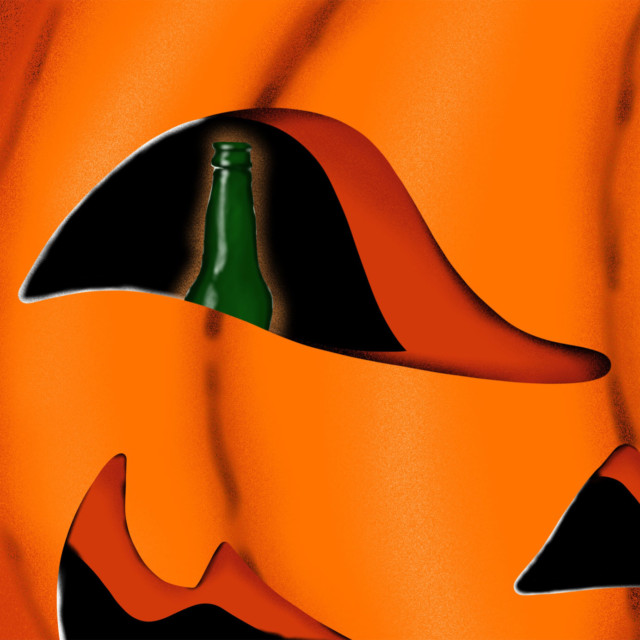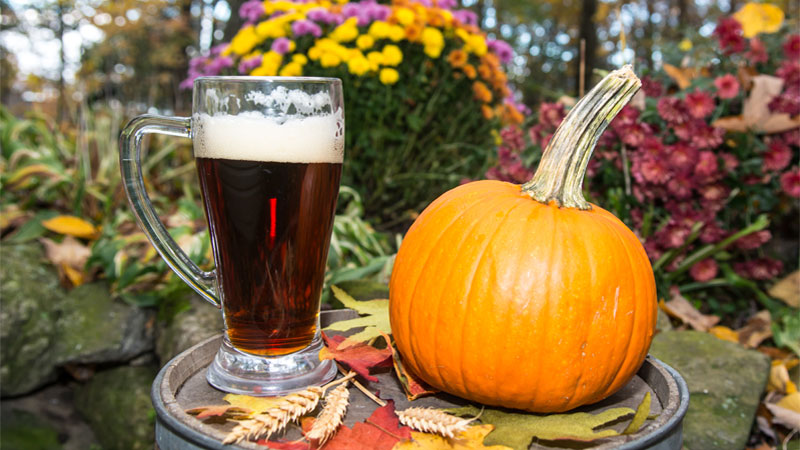This October, VinePair is celebrating our second annual American Beer Month. From beer style basics to unexpected trends (pickle beer, anyone?), to historical deep dives and new developments in package design, expect an exploration of all that’s happening in breweries and taprooms across the United States all month long.
Which came first, the pumpkin or the spice? While we may never know that answer, it is true that pumpkin beer came before the pumpkin spice latte. A little fact beer geeks should be proud of, doesn’t that make us innovative? But eye rolls and sarcasm are directed toward the special season of September (or August… or July) and October when this gourd-based ale takes over store shelves.
The formulation seems like it could be simple: make beer, dump in pumpkin, dump in spices. It’s not quite that easy, though — especially if you want to make a pumpkin beer that will still taste great at your Thanksgiving table (why does pumpkin picking season end with Halloween, anyway?).
There are some straightforward guidelines that will help you reach peak pumpkin performance. For example, use at least some real pumpkin.
“If you don’t use pumpkin, call it a Halloween beer,” Joe Bisacca, co-founder of Elysian Brewing, says. “You should call it what it is.” Bisacca and his team at Elysian are fanatics who have thrown an all-pumpkin beer festival annually since 2005, sometimes featuring more than 80 pumpkin-infused brews.
That advice may be a little obvious but plenty of pumpkin ales on the market don’t contain actual pumpkin. The rest of these tips from Tröegs, Schlafly, Elysian, and Holidaily cover the finer points of brewing this seasonal specialty.
Pick Your Pumpkin
“You get a little fuller mouthfeel from pumpkins, and some subtle flavors,” says John Trogner, brewmaster and co-founder of Tröegs Independent Brewing in Hershey, Pa. “Think butternut squash or zucchini bread.”
Even if the pumpkin doesn’t have a huge effect on the taste of the beer, carefully selecting the pumpkins to be used makes a difference. At Tröegs, the seasonal Master of Pumpkins is made exclusively with locally grown Pennsylvania longneck pumpkins that have more of a butternut squash flavor.
Getting a pumpkin from your local farmers market is a great way to infuse your homebrew with something special that commercial brews can’t offer. But when going whole gourd, a little extra work is required to achieve the desired flavor, says Trogner: “Make sure to get the stems off. And if you’re motivated, the seeds, too.”
These heirloom gourds undergo some cooking time in the brewery kitchens before they’re added to the beer. “Roasting softens up the pumpkins and allows us to puree them,” Trogner says. “It also caramelizes the sugars and adds a slight sweetness.”
Roasting or toasting whatever part of the pumpkin you decide to use in the beer — whole, seeds, and puree are all options — will help maximize the flavor extracted. Elysian, one of the earliest breweries to make a pumpkin beer when it released Night Owl back in 1997, toasts some of the pumpkin seeds used on brew day before adding them.
“I’m not really sure what effect the pumpkin seeds wind up having,” Bisacca says of the tradition at his brewery. “We added them in our first batches because they sounded good to try.”
At Schlafly Beer in St. Louis, experimentation with “concentrates, dehydrated powders, and pumpkin in all forms” led lead brewer Jared Williamson and his team to use pure pumpkin juice as the most efficient means of infusing the beer with pumpkin flavor. While it works for the large-scale production at Schlafly, where the Pumpkin Ale snagged a silver medal at the 2017 Great American Beer Festival, pressed pumpkin juice may be hard to source, and messy to make, for homebrewers.
Pumpkin puree, on the other hand, is readily available, and it’s exactly what Karen Hertz, “chief brewista” and founder of Holidaily Brewing Co. in Golden, Colo., uses in her pumpkin ale, Patchy Waters.
She says, “To have the right balance between the pumpkin and the spices, it’s ideal to use the real thing [pumpkin].” She adds that imitation flavors and extracts can have a fake-tasting quality to them.
Getting “the real thing” into your beer is as easy as opening a can of puree and adding it right to the mash. For more pumpkin-pie flavor, lightly brown the puree in a pan first and then scrape the caramelized pumpkin into the mash. To match the ratio that Elysian uses when adding pumpkin to beers, you’re looking for about 6.5 ounces of pumpkin puree per gallon of beer/wort.
Spice Is Nice
“For the pumpkin ale, when you add in that spice regimen, that’s when the beer really comes alive,” Williamson says. A typical pumpkin spice mixture will contain cinnamon, nutmeg, and cloves, and sometimes allspice and/or ginger. (The most common mix is ground cinnamon, nutmeg, ginger, and cloves. Ginger is the most expensive spice for the flavor, so a lot of beers leave it out. Allspice is the least used of the mix.)
At both Schlafly and Elysian, spices are added after fermentation is complete, right before filtering and bottling. Pasteurized spices are added to the fermenter and allowed to infuse for a short period of time (in hours, not days) before the beer is packaged and carbonated. At home, taste your beer every six hours until you notice the spice at the level you want.
Williamson says a healthy ale fermentation can scrub out spice flavor because of the vigorous blow off, so any spices added before yeast is pitched may be lost.
There’s also flavor changes to consider; Bisacca says to ask yourself, “Should it be part of fermentation, or does the yeast modify it negatively?”
Another option is to add the spices to the mash, which is the route both Troegs and Holidaily take. This eliminates the need to pasteurize the spices (because everything will be boiled). However, homebrewers should be careful not to add too many spices at this stage as there is no way to stop the flavor infusion using this method. It’s important to be especially careful with tannin-heavy spices like allspice and nutmeg that can become bitter and astringent in large quantities.
All About That Base
Generally, pumpkin beers will have enough body to carry the flavor of the spices without feeling watery. At Schlafly, Williamson says, “We do mash a little higher [temperature] to have a higher final gravity and more mouthfeel.” He adds that the base beer is like a malt-forward strong ale before the spices are added to it.
Trogner mentions keeping with the styles of the season. “We love those fall flavors — nut browns, ambers, porters,” he says. Although the base of Master of Pumpkins is a twist on the typical dark beer, “We think a Belgian-style yeast is a perfect complement for those fall spices.”
Another consistent aspect of pumpkin ale base beers: subtle hopping. The intense aromas of citrusy or “dank” hops clash with the spice regimen in these beers. Across the board, the brewers here say hops are just there to add enough bitterness to balance the malt and pumpkin sweetness in these beers.
Get Creative
Because pumpkin on its own is so subtle, it can mesh well with the flavors of many beer styles. The team at Elysian doesn’t think narrowly about the season when they’re dreaming up their next pumpkin brew.
“We did a Ginger Pumpkin Pilsner (Hansel & Gretel),” Bisacca says. To keep in balance with the light body and flavors of the lager, “the pumpkin and spicing needed to be very delicate.”
He suggests that as long as the final product is in balance and drinkable, there’s no shortage of what you can add to a pumpkin beer. Culinary inspirations like curry, rosemary, and thyme came to mind — as well as more common pumpkin pairings such as coffee and vanilla.
It’s not what you can add with a pumpkin beer, but rather how much. “The bigger question is overdoing it – make sure you can drink it!” he says.

